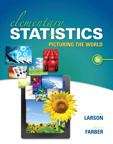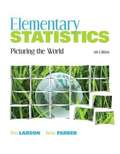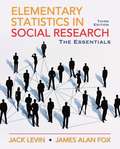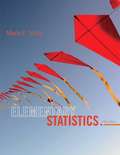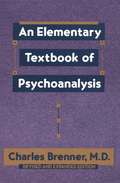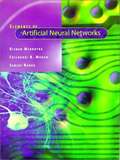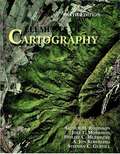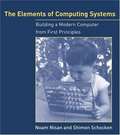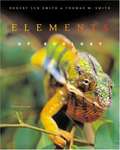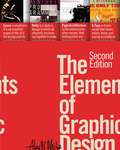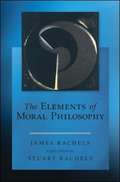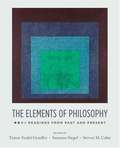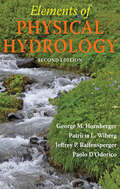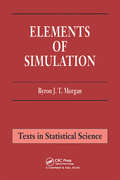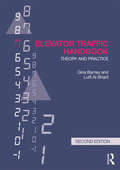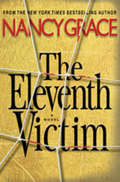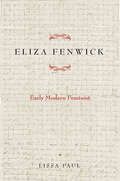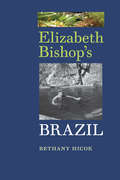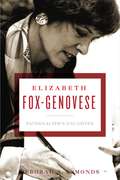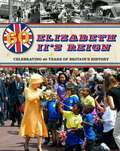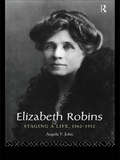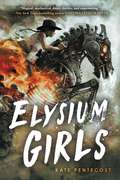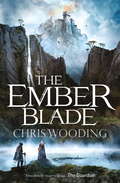- Table View
- List View
Elementary Statistics: Picturing the World, 6th Edition
by Ron Larson Betsy FarberElementary Statistics: Picturing the World, Sixth Edition, provides stepped out instruction, real-life examples and exercises, and the use of technology to offer the most accessible approach. The authors carefully develop theory through strong pedagogy, and examples show how statistics is used to picture and describe the world. In keeping with the premise that students learn best by doing, it includes more than 210 examples and more than 2300 exercises, to make the concepts of statistics a part of students' everyday lives.
Elementary Statistics: Picturing the World (Fifth Edition)
by Ron Larson Betsy FarberThis textbook is written with a balance of rigor and simplicity. It combines step-by-step instruction, real-life examples and exercises, carefully developed features, and technology that makes statistics accessible to all. The Fifth Edition has a thorough update of the key features, examples, and exercises.
Elementary Statistics in Social Research: The Essentials
by James Fox Jack LevinThis text provides a streamlined and accessible introduction to statistics for students in sociology, criminal justice, political science, social work, and other social sciences. This text offers an essential and accessible overview to the introduction to social statistics. Clearly written with detailed step-by-step illustrations of statistical procedures, this text provides clear and logical explanations for the rationale and use of statistical methods of social research. Numerous end-of-chapter questions in every chapter reinforce key concepts to students.
Elementary Statistics (Twelfth Edition)
by Mario F. TriolaFrom SAT scores to job search methods, statistics influences and shapes the world around us. Marty Triola's text continues to be the bestseller because it helps students understand the relationship between statistics and the world, bringing life to the theory and methods. Elementary Statistics raises the bar with every edition by incorporating an unprecedented amount of real and interesting data that will help instructors connect with students today, and help them connect statistics to their daily lives. The Twelfth Edition contains more than 1,800 exercises, 89% of which use real data and 85% of which are new. Hundreds of examples are included, 91% of which use real data and 84% of which are new. New coverage of Ethics in Statistics highlights new guidelines that have been established in industry.
The Elements of Alternate Style: Essays on Writing and Revision
by Wendy BishopElements of Alternate Style contributes to a better understanding of the writing process in general and the stylistic options available to every serious writer. It demonstrates how by teaching alternate and traditional styles in tandem, by focusing on revision as invention, we can help students become newly engaged with their texts-even "school writing. " In this edited collection, successful classroom instructors explore and apply these ideas, drawing from composition pedagogy, creative writing technique, and critical theory. The six essays in Part I delineate an initial classroom sequence. . The authors ask writers to try writing exercises and to reconsider how they have constructed essays in the past-how they might reconstruct them today by looking and looking again, by fracturing and creating double voices, by reconsidering the place of research. Part II pushes these explorations further in five essays that contend that writing is about taking risks, trying (sometimes failing), learning from exploration, from play, from radical twists and turns. Part III engages even broader issues of identity, technology, correctness, and editing. Elements of Alternate Style is a powerful, liberating resource that validates innovative writing instruction and offers a rich array of voices and techniques.
Elements of Artificial Neural Networks
by Kishan Mehrotra Chilukuri K. Mohan Sanjay RankaElements of Artificial Neural Networks provides a clearly organized general introduction, focusing on a broad range of algorithms, for students and others who want to use neural networks rather than simply study them. The authors, who have been developing and team teaching the material in a one-semester course over the past six years, describe most of the basic neural network models (with several detailed solved examples) and discuss the rationale and advantages of the models, as well as their limitations. The approach is practical and open-minded and requires very little mathematical or technical background. Written from a computer science and statistics point of view, the text stresses links to contiguous fields and can easily serve as a first course for students in economics and management. The opening chapter sets the stage, presenting the basic concepts in a clear and objective way and tackling important--yet rarely addressed--questions related to the use of neural networks in practical situations. Subsequent chapters on supervised learning (single layer and multilayer networks), unsupervised learning, and associative models are structured around classes of problems to which networks can be applied. Applications are discussed along with the algorithms. A separate chapter takes up optimization methods. The most frequently used algorithms, such as back propagation, are introduced early on, right after perceptrons, so that these can form the basis for initiating course projects. Algorithms published as late as 1995 are also included. All of the algorithms are presented using block-structured pseudo-code, and exercises are provided throughout. Software implementing many commonly used neural network algorithms is available at the book's website. Transparency masters, including abbreviated text and figures for the entire book, are available for instructors using the text.
Elements Of Cartography
by Arthur H. Robinson Joel L. Morrison Phillip C. Muehrcke A Jon. Kimerling Stephen C. Guptill A. Jon KimerlingElements of Cartography, 6e continues its reputation as the market leader by integrating the latest in modern technology with traditional cartographic principles.
The Elements of Computing Systems: Building a Modern Computer from First Principles
by Noam Nisan Shimon SchockenIn the early days of computer science, the interactions of hardware, software, compilers, and operating system were simple enough to allow students to see an overall picture of how computers worked. With the increasing complexity of computer technology and the resulting specialization of knowledge, such clarity is often lost. Unlike other texts that cover only one aspect of the field, The Elements of Computing Systems gives students an integrated and rigorous picture of applied computer science, as its comes to play in the construction of a simple yet powerful computer system. Indeed, the best way to understand how computers work is to build one from scratch, and this textbook leads students through twelve chapters and projects that gradually build a basic hardware platform and a modern software hierarchy from the ground up. In the process, the students gain hands-on knowledge of hardware architecture, operating systems, programming languages, compilers, data structures, algorithms, and software engineering. Using this constructive approach, the book exposes a significant body of computer science knowledge and demonstrates how theoretical and applied techniques taught in other courses fit into the overall picture. Designed to support one- or two-semester courses, the book is based on an abstraction-implementation paradigm; each chapter presents a key hardware or software abstraction, a proposed implementation that makes it concrete, and an actual project. The emerging computer system can be built by following the chapters, although this is only one option, since the projects are self-contained and can be done or skipped in any order. All the computer science knowledge necessary for completing the projects is embedded in the book, the only pre-requisite being a programming experience. The book's web site provides all tools and materials necessary to build all the hardware and software systems described in the text, including two hundred test programs for the twelve projects. The projects and systems can be modified to meet various teaching needs, and all the supplied software is open-source.
Elements of Ecology 5th Edition
by Robert Leo Smith Thomas M. SmithWith a modular organization and a beautiful four color art program, the fourth edition of this leading text for non-majors continues to provide a clear presentation of the principles of ecology and illustrate their relation to today's environmental issues. Far-reaching in its coverage, the fourth edition provides the most up-to-date information with a new chapter on global warming and deforestation. It also focuses on ecology as a science, providing the basic background information needed to show the relevance of studying environmental problems on a global scale.
The Elements of Graphic Design: Space, Unity, Page Architecture, and Type (2nd Edition)
by Alex W. WhiteThis pioneering work has been wholly revised and expanded to feature a new dimension of inspiring and counter-intuitive ideas to thinking about graphic design relationships and provides designers, art directors, and students--regardless of experience--with a unique approach to successful design. The second edition includes a new section on Web design; new discussions of modularity, framing, motion and time, rules of randomness, and numerous quotes supported by images and biographies.
The Elements of Moral Philosophy 8th Edition
by James Rachels Stuart RachelsThe Elements of Moral Philosophy by James Rachels and Stuart Rachels is a best-selling text for undergraduate courses in ethics. Thirteen thought-provoking chapters introduce readers to major moral concepts and theories in philosophy through clear, understandable explanations and compelling discussions.
The Elements of Philosophy: Readings from Past and Present
by Susanna Siegel Steven M. Cahn Tamar Szabó GendlerThe Elements of Philosophy: Readings from Past and Present offers an extensive collection of classic and contemporary readings, organized topically into five main sections: Religion and Belief, Moral and Political Philosophy, Metaphysics and Epistemology, Philosophy of Mind and Language, and Life and Death. Within these broad areas, readings are arranged in clusters that address both traditional issues--such as the existence of God, justice and the state, knowledge and skepticism, and free will--and contemporary topics--including God and science, just war theory, vegetarianism, and time travel. Carefully chosen selections from a wide range of pre-20th-century philosophers are paired with writings from more than fifty leading contemporary philosophers and thinkers. The traditional philosophers represented range from Plato and Aristotle to Immanuel Kant and A. J. Ayer; the contemporary philosophers include Saul Kripke, David Lewis, Thomas Nagel, Derek Parfit, Hilary Putnam, Robert Nozick, Judith Jarvis Thomson, John Rawls, Bernard Williams, and Susan Wolf. Also included are selections from linguist Noam Chomsky, physicist Albert Einstein, and psychologist William James. Edited by a team of scholars who are also highly esteemed instructors, The Elements of Philosophy is uniquely student-friendly. A team of undergraduate philosophy majors played a central role in helping to select topics, choose readings, and identify terms likely to require clarification. In response to their suggestions, the volume includes detailed introductions to each section, explanatory footnotes that define unfamiliar terms and concepts, an extensive glossary, and a guide to further resources. A companion Instructor's Manual, available on CD, offers article summaries, suggested essay questions, reading guides, model handouts, and sample syllabi. One of the most extensive and expansive anthologies available, The Elements of Philosophy is an ideal choice for both general and targeted introductory philosophy courses.
Elements of Physical Hydrology
by George M. Hornberger Patricia L. Wiberg Jeffrey P. Raffensperger Paolo D'OdoricoThe most cogent textbook ever produced on the topic, this revised and expanded edition will be welcomed by students and professionals alike.Among the many diverse aspects of environmental science, none is more critical to the future of society and nature than water. Understanding the role of water on Earth and making good decisions regarding water conservation and hydrological hazards depends on learning the fundamentals of physical hydrology. This textbook, now in an expanded second edition, provides the clearest opportunity for students to absorb those fundamentals. Written at an introductory level, Elements of Physical Hydrology covers virtually every aspect of this subject, including:• The hydrological cycle• Water budgets at catchment to global scales • Spatial and temporal aspects of precipitation• Evapotranspiration• Fluid dynamics and the Bernoulli equation• Laminar and turbulent flows• Open channel flow • Flood movement through reservoirs and channels • Flood frequency analysis• Groundwater flow• Aquifer characterization• Land subsidence• Soil moisture dynamics• Flow in the unsaturated zone• Hydrologic controls on vegetation • Biotic controls on hydrological processes• Runoff generation from surface and subsurface sources• Catchment models• The water-food-energy nexus• The globalization of water• Impacts of changing climateLayering one topic upon the next, Elements of Physical Hydrology succeeds in moving from simple, easy-to-grasp explanations through equations and models in a manner that will leave students new to the topic eager to apply their knowledge. Professionals in related disciplines will also find this book ideal for self-study. Thoughtfully illustrated, carefully written, and covering a broad spectrum of topics, this classic text clarifies a subject that is often misunderstood and oversimplified.
Elements of Simulation (Chapman And Hall/crc Texts In Statistical Science Ser. #4)
by Byron J.T. MorganThe use of simulation in statistics dates from the start of the 20th century, coinciding with the beginnings of radio broadcasting and the invention of television. Just as radio and television are now commonplace in our everyday lives, simulation methods are now widely used throughout the many branches of statistics, as can be readily appreciated from reading Chapters 1 and 9. The book has grown out of a fifteen-hour lecture course given to third-year mathematics undergraduates at the University of Kent, and it could be used either as an undergraduate or a postgraduate text. Simulation may either be taught as an operational research tool in its own right, or as a mathematical method which cements together different parts of statistics and which may be used in a variety of lecture courses. In the last three chapters indications are made of the varied uses of simulation throughout statistics. Alternatively, simulation may be used to motivate subjects such as the teaching of distribution theory and the manipulation of random variables, and Chapters 4 and 5 especially will hopefully be useful in this respect.
Elena, Princesa of the Periphery: Disney’s Flexible Latina Girl (Latinidad: Transnational Cultures in the United States)
by Diana Leon-BoysIn the summer of 2016, Disney introduced its first Latina princess, Elena of Avalor. Princesa of the Periphery explores this Disney property using multiple case studies to understand its approach to girlhood and Latinidad. Following the circuit of culture model, author Diana Leon-Boys teases out moments of complex negotiations by Disney, producers, and audiences as they navigate Elena’s circulation. Case studies highlight how a flexible Latinidad is deployed through corporate materials, social media pages, theme park experiences, and the television series to create a princess who is both marginal to Disney’s normative vision of princesshood and central to Disney’s claims of diversification. This multi-layered analysis of Disney’s mediated Latina girlhood interrogates the complex relationship between the U.S.’s largest ethnic minority and a global conglomerate that stands in for the U.S. on the global stage.
Elevator Traffic Handbook: Theory and Practice
by Gina Barney Lutfi Al-SharifThis second edition of this well-respected book covers all aspects of the traffic design and control of vertical transportation systems in buildings, making it an essential reference for vertical transportation engineers, other members of the design team, and researchers. The book introduces the basic principles of circulation, outlines traffic design methods and examines and analyses traffic control using worked examples and case studies to illustrate key points. The latest analysis techniques are set out, and the book is up-to-date with current technology. A unique and well-established book, this much-needed new edition features extensive updates to technology and practice, drawing on the latest international research.
The Eleventh Victim
by Nancy GraceThe Eleventh Victim, from former prosecutor Nancy Grace, is a tense thriller depicting a battle of wits between a lawyer, a serial killer, and the NYPD As a young psychology student, Hailey Dean's world explodes when Will, her fiancé, is murdered just weeks before their wedding. Reeling, she fights back the only way she knows how: In court, prosecuting violent crime...putting away the bad guys one rapist, doper, and killer at a time. But dedicating her life to justice takes a toll after years of trials and the endless tide of victims calling out from crime scene photos and autopsy tables. Just as she grows truly weary, a serial killer unlike any other she's encountered begins to stalk the city of Atlanta, targeting young prostitutes, each horrific murder bearing his own unique mark. This courtroom battle will be her last. Hailey heads for Manhattan to pick up the pieces of the life she had before Will's murder, training as a therapist. In a vibrant new world, she finally leaves her ghosts behind. But then her own clients are brutally murdered, one by one, by a copycat using the same M.O. as the Atlanta killer she hunted down years before. Hailey's own DNA is found at the crime scenes. As the body count rises across Manhattan, Hailey is forced to match wits not only with a killer, but with the famed NYPD. Unless she returns to her former life and solves the case, still more innocent people will die at the hands of a killer who plans to get her before she can get him!
Eliza Fenwick: Early Modern Feminist (Early Modern Feminisms)
by Lissa PaulThis captivating biography traces the life of Eliza Fenwick, an extraordinary woman who paved her own unique path throughout the late eighteenth and nineteenth centuries as she made her way from country to country as writer, teacher, and school owner.Lissa Paul brings to light Fenwick’s letters for the first time to reveal the relationships she developed with many key figures of her era, and to tell Fenwick’s story as depicted by the woman herself. Fenwick began as a writer in the radical London of the 1790s, a member of Mary Wollstonecraft’s circle, and when her marriage crumbled, she became a prolific author of children’s literature to support her family. Eventually Fenwick moved to Barbados, becoming the owner of a school while confronting the reality of slavery in the British colonies. She would go on to establish schools in numerous cities in the United States and Canada, all the while taking care of her daughter and grandchildren and maintaining her friendships through letters that, as presented here, tell the story of her life.Distributed for the University of Delaware Press
Elizabeth Bishop's Brazil
by Bethany HicokWhen the American poet Elizabeth Bishop arrived in Brazil in 1951 at the age of forty, she had not planned to stay, but her love affair with the Brazilian aristocrat Lota de Macedo Soares and with the country itself set her on another course, and Brazil became her home for nearly two decades. In this groundbreaking new study, Bethany Hicok offers Bishop’s readers the most comprehensive study to date on the transformative impact of Brazil on the poet’s life and art. Based on extensive archival research and travel, Elizabeth Bishop’s Brazil argues that the whole shape of Bishop’s writing career shifted in response to Brazil, taking on historical, political, linguistic, and cultural dimensions that would have been inconceivable without her immersion in this vibrant South American culture. Hicok reveals the mid-century Brazil that Bishop encountered--its extremes of wealth and poverty, its spectacular topography, its language, literature, and people--and examines the Brazilian class structures that placed Bishop and Macedo Soares at the center of the country’s political and cultural power brokers. We watch Bishop develop a political poetry of engagement against the backdrop of America’s Cold War policies and Brazil’s political revolutions. Hicok also offers the first comprehensive evaluation of Bishop’s translations of Brazilian writers and their influence on her own work. Drawing on archival sources that include Bishop’s unpublished travel writings and providing provocative new readings of the poetry, Elizabeth Bishop’s Brazil is a long-overdue exploration of a pivotal phase in this great poet’s life and work.
Elizabeth Fox-Genovese: Paternalism's Daughter
by Deborah A. SymondsIn her provocative politics, which confront us still with the complexities of left and right, and her constant search for her place in the world, Fox-Genovese’s story resonates more strongly than ever.
Elizabeth II's Reign - Celebrating 60 years of Britain's History
by Jacqui BaileyElizabeth II's Reign examines the recent history of Britain. Exploring the Britain the Queen was born into and took over when her reign began, the Commonwealth, changing social times / family, fashion, technology and work the book builds up a picture of how life in Britain has changed.The book is bought alive with humourous cartoon and by memories in the form of quotes from people who remember the events and changes from the past 60 years. It is illustrated with pictures of the Queen and the Royal family and historical photos of life in Britain.With panels of facts about the Queen and the Royal Family, this is a great read for children and young adults in the year of the Queen's Diamond Jubilee.Contents include:Sixty years on the throneThe end of the War (Rationing; marriages and births; a crumbling Empire; united for peace)A new Queen (King for a year; the Queen's father; coronation day; open to the public; good times...and bad)Family life (getting married; seen not heard; school days; pass or fail; all together; women's rights; all sorts of families; somewhere to live; instant houses; building blocks)Healthier and wealthier (paying the price; health for free; changing jobs; haves and have nots; the poverty line; going places; travelling by train; on the roads; it's good to talk; talking and walking, using computers)The way we live (a changing population; favourite food; super shops; well dressed; minis, bell-bottoms and safety pins; at the movies; what's on the box; from ballroom to the Beatles; festival time; by the seaside; packaged up)Looking aheadTimeline; further informationIndex
Elizabeth Robins: 1862-1952
by Prof Angela John Angela V. JohnA woman of extraordinary energy, talent and versatility. Elizabeth Robins was an actress who popularised Ibsen on the British stage, a prolific and popular writer of novels and non-fiction, and an Edwardian suffragette. Her extensive circle of friends included Florence Bell, Henry James, John Masefield and William Archer. She worked with the Pankhursts and knew the Woolfs. Through examining the life and work of this vivid and transatlantic figure born during the American Civil War yet surviving into the England of the 1950s, Angela John raises questions about the shaping of historical identities. Situating Elizabeth Robins's achievement in the context of the British and American cultural history of the period, this is a book which will attract historians, teachers and students of theatre studies and all those fascinated by biography.
Elysium Girls
by Kate PentecostFrom a lush, dazzlingly original new voice in young adult fantasy comes an epic clash of witches, gods and demons as the fate of humanity hangs in the balance. <P><P>Elysium, Oklahoma, is a town like any other. Respectable. God-fearing. Praying for an end to the Dust Bowl. Until the day the people of Elysium are chosen by two sisters: Life and Death. And the Sisters like to gamble against each other with things like time, and space, and human lives. Elysium is to become the gameboard in a ruthless competition between the goddesses. <P><P>The Dust Soldiers will return in ten years' time, and if the people of Elysium have not proved themselves worthy, all will be slain. <P><P>Nearly ten years later, seventeen-year-old Sal Wilkinson is called upon to lead Elysium as it prepares for the end of the game. But then an outsider named Asa arrives at Elysium's gates with nothing more than a sharp smile and a bag of magic tricks, and they trigger a terrible accident that gets both Sal and Asa exiled into the brutal Desert of Dust and Steel. <P><P>There Sal and Asa stumble upon a gang of girls headed by another exile: a young witch everyone in Elysium believes to be dead. As the apocalypse looms, they must do more than simply tip the scales in Elysium's favor -- only by reinventing the rules can they beat Life and Death at their own game in this exciting fantasy debut.
The Ember Blade (The\darkwater Legacy Ser.)
by Chris WoodingA land under occupation. A legendary sword. A young man's journey to find his destiny.Aren has lived by the rules all his life. He's never questioned it; that's just the way things are. But then his father is executed for treason, and he and his best friend Cade are thrown into a prison mine, doomed to work until they drop. Unless they can somehow break free . . .But what lies beyond the prison walls is more terrifying still. Rescued by a man who hates him yet is oath-bound to protect him, pursued by inhuman forces, Aren slowly accepts that everything he knew about his world was a lie. The rules are not there to protect him, or his people, but to enslave them. A revolution is brewing, and Aren is being drawn into it, whether he likes it or not.The key to the revolution is the Ember Blade. The sword of kings, the Excalibur of his people. Only with the Ember Blade in hand can their people be inspired to rise up . . . but it's locked in an impenetrable vault in the most heavily guarded fortress in the land.All they have to do now is steal it . . .
